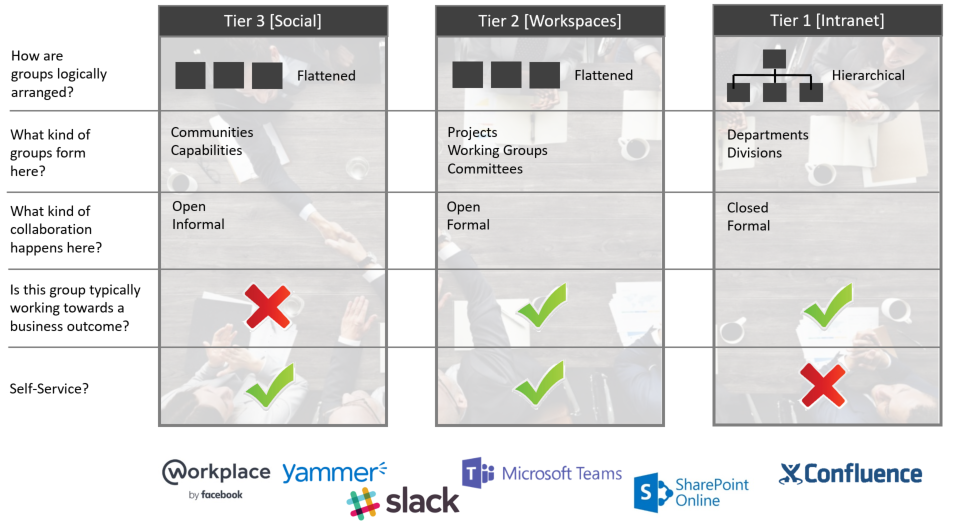There are many ways people collaborate within your organisation. You may or may not enjoy the fruits of that collaboration. Does your current collaboration landscape cater for the wide variety of groups that form (organically or inorganically) to build relationships and develop your business?
Moving to the cloud is a catalyst for re-evaluating your collaboration solutions and their value. Platforms like Office 365 are underpinned by search/discovery tools that can traverse and help draw insight from the output of collaboration, including conversations and connections between people and information. Modern applications open up new opportunities to build working groups that include people form outside your organisation with whom you can freely, and securely share content.
I’ve been in many discussions with customers on how enabling technologies play a role in the modern collaborative landscape. Part of this discussion is about identifying the various group archetypes and how characteristics can align or differ. I’ve developed a view that forms these groups into three ‘tiers’, as follows:

Organisations should consider a solution for each tier, because there are requirements in each tier that are distinct. The challenge for an organisation (as part of a wider Digital Workplace strategy) is to:
- Understand how existing and prospective solutions will meet collaboration requirements in each tier, and communicate that understanding.
- Develop a platform where information managed in each tier can be shared with other tiers.
Let’s go into the three tiers in more detail.
Tier One (Intranet)
Most organisations I work with have an established Tier One business solution, like a corporate intranet. These are the first to mature. They are logically represented as hierarchy of containers (i.e. sites), with a mix of implicit and explicit access control (and associated auditing difficulties). The principal use is to store documents and host authored web content (such as news). Tier One systems are usually dependent on solutions in other tiers to facilitate (and retain) group conversations or discussions.
- Working groups are hierarchical and long term, based off a need to model the relationships between groups in an organisation (e.g. Payroll sits under Finance, Auditing sits under Payroll )
- Activity here is closed and formal. Contribution is restricted to smaller groups.
- Information is one-way and top down. Content is authored and published for group-wide or organisation-wide consumption.
- To get things done, users will be more dependent on a Service Desk (for example: managing access control, provisioning new containers), at the cost of agility.
- Groups are established here to work towards a business outcome or goal (deliver a project, achieve our organisations objectives for 2019).
Tier Three (Social Network):
Tier Three business solutions represent your organisation’s social network. Maturity here ranges from “We launched [insert platform here] and no-one is using it” to “We’ve seen an explosion in adoption and it’s Giphy city”. They are usually dependent on solutions in other tiers to provide capabilities such as web content/document management (case in point: O365 Groups and Yammer).
- Tier Three groups here are flattened, and cannot by design model a hierarchy. They tend to be long term, and prone to stagnation.
- Groups represent communities, capabilities and similar interest groups, all of which are of value to your organisation. At this point you say: “I understand how the ‘Welcome to Yammer’ group is valuable, but what about the ‘Love Island Therapy’ group?”. At this point I say: “Here you have a collection of individuals who are proactively using and adopting your platform”.
- Unlike in the other tiers, groups here tend to have no business outcome, although they’ll have objectives to gain momentum and visibility.
- Collaboration here is open (public) and informal, down to the #topics people discuss and the language that is used.
- A good Tier Three solution will be fully self service, subject to a pre-defined usage policy. There should be no restrictions beyond group level moderation in terms of who can contribute. If it’s public or green it’s fair game!
- Tier Three groups have the biggest membership, and can support thousands of members.
Tier Two (Workspaces)
Tier Two comes last, because in my experience it’s the capability that is the least developed in organisations I work with and the last to mature.
A Tier Two business solution delivers a collaborative area for teams such as working groups, committees and project teams. They will provide a combination of features inherent in Tier One and Tier Three solutions. For example, the chat/discussion capabilities of a Tier Three solution and the content management capabilities of a Tier One solution
- Tier Two groups here are flattened, and cannot by design model a hierarchy. They tend to me short term, in place to support a timeboxed initiative or activity.
- Groups represent working groups, committees and project teams, with a need to create content and converse. These groups are coalitions, including representation from different organisational groups that need to come together to deliver an outcome.
- Groups work towards a business outcome, for example: develop a business case, deliver a document.
- Collaboration here tends to be closed (restricted to a small group) and semi-formal, but it is possible for such groups to be both closed, formal and open, informal.
- A good Tier Two solution will be fully self service, subject to a pre-defined usage policy. There should be no restrictions beyond group level moderation in terms of who can contribute.
- Groups represent a small number of individuals, and do not grow to the size of departmental (Tier One) groups or social (Tier Three) groups.
The three-tiers view identifies the different ways collaboration happens with in your organisation. It is solution agnostic, you can advocate any technology in any tier if it meets the requirement. The view helps evaluate the diverse needs of your organisation, and determine how effective your current solutions are at meeting requirements for collaboration and information working.

